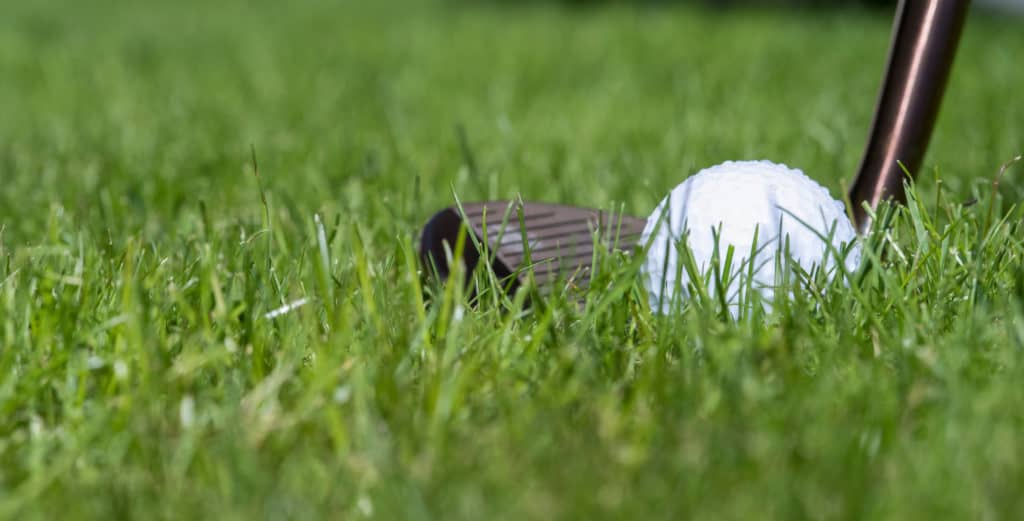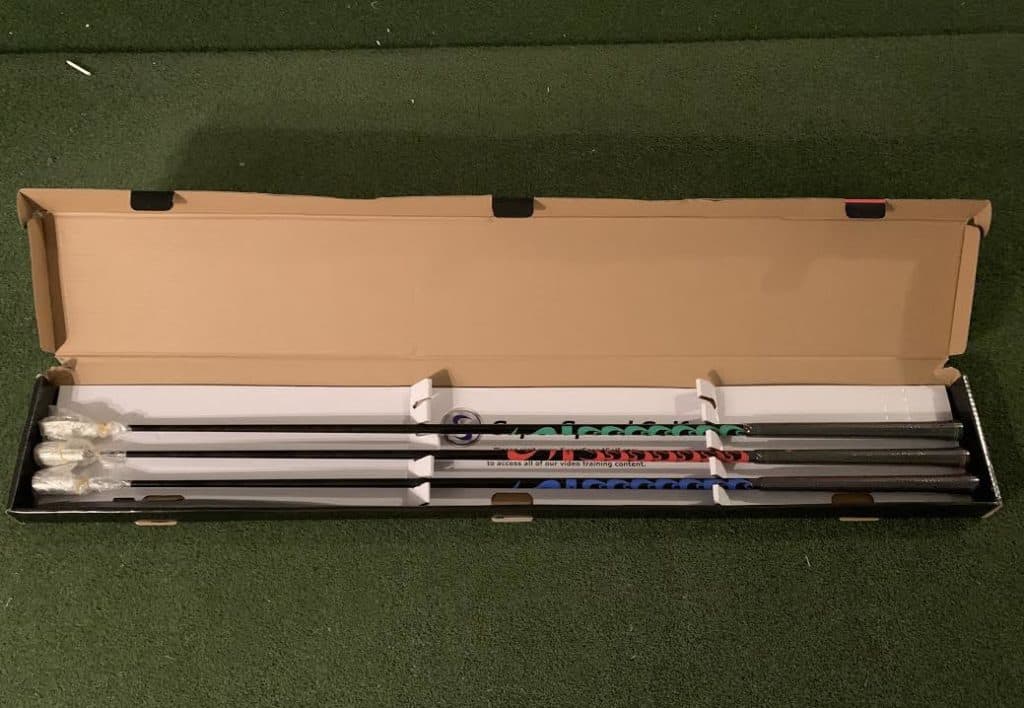The major difference in the lob wedge vs the sand wedge is the amount of loft. Lob wedges typically have between 58 and 64 degrees of loft, while a sand wedge is between 54 and 57 degrees.
There are many different ways to pick the 14 clubs for your bag to give yourself the best chance of playing quality golf.
The wedges and which ones you carry might be the most vital selection you make as these wedges are your scoring clubs on short par 4s and all par 5s. They also help you save shots around the green when you miss the green with your approach shot.
For years, you might see a golfer carry a pitching wedge and a sand wedge. It was almost unheard of for a golfer to carry a 60 degree lob wedge. However, courses became more and more difficult as greens became firmer and faster.
Without enough loft, the golfer is at a major disadvantage when compared to a golfer with the right loft on their wedges.
Now you might find some pros like Phil Mickelson carrying a 64 degree lob wedge and really maxing out the loft and setting himself up to be able to hit some impressive flop shots.
Update: The sand wedge and lob wedge are essential clubs in most golf bags. I would recommend becoming an expert with the wedges if you want to take your game to the next level without adding additional swing speed.

Lob Wedge vs Sand Wedge: What are the Differences?
Once you get down to 52 and 53 degrees this is often referred to as a gap wedge to split the difference between the 48 degree pitching wedge and a 56 degree sand wedge.
The bottom line is that golfers have plenty of options in the range between 48 and 64, but must remember they only get 14 clubs and scoring shots and par saves are vital!
Another difference that the golfer can select with all wedges is the amount of bounce. This is the angle of the leading wedge and the more bounce a club has, the flatter the bottom of the club is. This helps the golfer slide underneath the ball on those delicate lob shots around the green. Oftentimes a golfer will carry a lob wedge that has more bounce than a sand wedge.
Low Wedge vs Sand Wedge: What are the Similarities?
They both have plenty of loft to his the majority of shots required around a green. The most skillful player might be able to not even use a lob wedge and instead use the sand wedge in these places.
This would provide flexibility to add another hybrid, fairway wood or long iron to his or her golf bag. If the golfer is truly skillful around the green, but struggles from the longer distance, this may be a quality option.
Another similarity is that both clubs can be used out of greenside bunkers. If you have a longer, flatter shot, the sand wedge would be your selection. If you short sided yourself and need to get the ball up quick and not fly it very far the lob wedge will most likely be the club of choice.
One last similarity is that the best golfers are able to add loft or take away loft with both the sand wedge and the lob wedge to provide the most flexibility in their game. They can open the face wide up and hit a flop shot or close down the loft and hit a driving, spinning shot that bounces a couple of times and comes to a stop.
Lob Wedge vs Sand Wedge: Which one should I chip with?
Most golfers should consider using both clubs in different situations. Having the versatility in your wedges makes you a more well rounded player.
Some golfers may prefer to get really comfortable with just one club. For example, Phil Mickelson hits the majority of his chip shots with a lob wedge. He will open or close the face to add loft or take the loft away.
The golfers that prefer this method will tell you that they can get a lot of practice in with that one club and are comfortable moving the ball around in their stance and closing the face down when they need to keep it lower.
The golfer who often chunks a shot or blades it across the green should learn to keep the club more at its natural loft and utilize the bounce on the bottom of the club. The chunked or bladed shot are often a result of too much leading edge catching the ground leading to the chunked shot or the fear or chunking which results in a bladed shot.
I have found that having a clock like system, for example taking your club back to 7:00, 8:00 or 9:00 and then picking a speed: fast, medium or slow gives you some great options. You can pick your sand wedge or lob wedge or something as flat as your 6 iron depending on where you want the ball to land and how much roll you have.
You see the golfer can have a system and practice this system to create many shot options. Determine your landing spot for the chip, select the club and then match up the length of the swing (clock system) with the speed of the swing (fast, medium, slow).
This takes away the yips for many people and can help the golfer focus on completing the task at hand and landing the ball close to the ideal landing location.
When to use a 60 degree wedge – Complete Post!
When to use a 56 degree wedge – Complete Post!

Lob Wedge vs Sand Wedge: Should I use the same make and model?
Yes, I would recommend picking one of the top club manufactures and buying all of your wedges from the same make and model. For example, go all Cleveland wedges, or Titleist or Callaway and buy the complete set.
I personally prefer the Cleveland wedges and have found success with this brand, but the other manufacturers have quality wedges as well.
Here is the Cleveland Wedge that I would recommend:
Lob Wedge vs Sand Wedge: What other wedges should I carry?
If your pitching wedge is a 48 degree club, I would recommend one of two options for your game.
- 48 degree pitching wedge, 52 degree gap wedge, 56 degree sand wedge and a 60 degree lob wedge
Or if you are fine with having larger gaps between your wedge, for example 6 degrees, this is another option.
- 48 degree pitching wedge, 54 degree sand wedge, 60 degree lob wedge.
If you are someone that struggles with hitting 70% shots or smaller, than go with the first option with the 4 total wedges. However, if you are someone that enjoys flighting the ball and can handle the smaller swing sizes, go with the second option and give yourself more flexibility to add a hybrid, fairway wood or long iron.
I personally am fine with the 48, 54, and 60 degree setup and can take loft off of both the 54 and 60 without and issues. I prefer to play the ball back in my stance a bit and play the lower, flying, spinning shot that holds the green just fine.
However, be warned, there are those that will struggle with this 6 degree loft, especially if they can flatten the club out and take some of the loft off of it.
Lob Wedge vs Sand Wedge: How far should I carry each club?
This will be dependent on your swing, but the majority of golfers carry a sand wedge between 75 and 105 yards and a lob wedge between 60 and 90 yards. Of course there are those with high swing speeds that can truly launch these clubs and carry them a further distance.
However, I would recommend not taking 100% swing with any of your wedges and staying within yourself in your golf swing. When you get to these scoring distances, the precision of the carry distance is more important than how far you can hit it!
If you are someone that wants more speed, the good news is that you can train for it with SuperSpeed Golf. I was able to increase my swing speed by 7-10 miles per hour with the driver and now have additional distance. This means hitting more wedges into the greens and having more scoring opportunities.
When you consider that the make percentage on an 8 foot putt on the PGA Tour is only 50%, you realize the importance of being able to control your sand wedge and lob wedge in addition to how extra driver distance can leave you more wedges resulting in shorter putts.
The analytics are pretty clear when it comes to distance and the major benefit that it has! Check out SuperSpeed Golf if you want an additional 5-8% increase in swing speed as early as your first training session.
Full review on SuperSpeed Golf!
Lob Wedge vs Sand Wedge: How to chart out your distances?
I would recommend doing the following to know the distances you hit each of your wedges in your bag. Follow this routine:
- Get access to a launch monitor.
- Take all of your wedges and hit 100%, 90%, and 80% shots.
- Track your distances and hit 5 shots at each percentage.
- Take the average carry distance.
- Create a chart that might look something like this below
| Club | Carry Distance (100%) | 90% | 80% |
| 4 iron | 190 | ||
| 5 iron | 181 | ||
| 6 iron | 171 | ||
| 7 iron | 163 | ||
| 8 iron | 153 | ||
| 9 iron | 143 | ||
| P Club | 130 | ||
| PW Club | 118 | 110 | 102 |
| SW Club | 105 | 97 | 91 |
| LW Club | 90 | 82 | 74 |
I would highly recommend that if you are even somewhat serious about the game of golf, you should check out the portable launch monitors (I highly recommend the SkyTrak!) on the market today. These amazing, technological devices are a complete game changer. Having feedback on the following areas is impressive and can improve your game:
- Ball speed
- Carry distance
- Spin rate
- Spin axis
- Club path
- Launch angle
Not only can it help you improve your swing, but you can test out different golf balls, golf clubs and other golf related items to truly measure what is best for your game. You can test to see what golf you hit furthers, or most precise or even which one has the least amount of curve or the most amount of spin with your wedges.
SkyTrak Launch Monitor: The ultimate game improvement tool!
Here are my top 3 recommend affordable golf launch monitors:
If you visit any PGA Tour stop you will see the majority of professionals use a launch monitor at some point throughout the week . Many are monitoring their club face, swing path relationship as well as swing speed. These are important numbers to monitor to make sure you are keeping your swing within a certain range.
I would also recommend checking and purchasing a range finder to add to your bag! This piece of technology will give your the exact distance to the pin and take slope into consideration. Here is a quality option:
Low Wedge vs Sand Wedge: Do I need a 64 degree lob wedge?
Unless you are playing in a US Open style tournament or course, then most people will be fine with a 60 degree lob wedge. Some even take 2 degrees off and are comfortable with a 58 degree lob wedge.
The struggle you will have is the gap between the 64 and your sand wedge, unless you take out another long club and carry 5 wedges. It doesn’t hurt to have one and have the option of going to it if you are an elite golfer, playing highly difficult courses with firm and fast greens that push the limits.
More Info on SuperSpeed Golf
I mentioned above that I was able to increase my swing speed by 7-10 miles per hour on average with through training with the SuperSpeed Golf System. This overspeed training protocol is based on the science surrounding overspeed training. The concept is that you will swing and train with lighter clubs and one heavier club to train the body and mind to be able to swing faster. In order to swing faster, you have to train to swing faster.
This every other day program that only takes a 15 minute training session every other day can add to 5-8% in swing speed, which could mean 20-30 yards in total distance with your driver. Are you ready to commit to this routine every other day and take your swing speed to the next level? Check out the current pricing below at SuperSpeed Golf!

Lob Wedge vs Sand Wedge: The fastest way to lower your scores
The fastest way to lower your scores in golf is through the short game. If you can get really good at saving par by chipping it closely, you might be surprised how quickly you can become a 70s shooter in golf.
For examples, let’s say you hit 8 greens in regulation. This leaves 10 chip shots you have to hit. If you can get up and down and save par 4 out of 10 times, and two putt the 8 greens you hit in regulation, this leaves you at around 78 for your score for 18 holes!
It surely is the fastest way to golf improvement. Most people can hit a decent number of green anywhere from 6-8 and once you can get up and down at the 40-50% rate, you are talking about shooting some quality scores.
Did you know that a scratch golfer gets up and down for par at around 54% on average? Check out this chart below on the stats of the typical scratch golfer:
What Does Scratch Golf Look Like – Stats Breakdown
THE STATS – The Recipe
| Greens in Regulation | 67% |
| Fairways Hit | 53% |
| Putts Per Hole | 1.67 |
| Scrambling | 54% |
| Sand Saves | 59% |
| Average Driving Distance | 251 |
Take Action – What You Can Do Today to Get Better
What does this mean for you? I believe in the following recipe to get better:
1 – Improve your motion in the golf swing by identifying a golf instructor. Here are some options:
Here is a list of golf instructors that we have reviewed:
2 – Train to swing faster and improve your swing speed. Here are some options:
Looking to gain more Speed and Distance in your swing. Two Options:
3 – Understand course strategy and work to break through your next barrier. Here is a series on breaking through:
We have provided guides on how to break 100, 90, 80 and 70. Check out more below, if interested.
4 – Practice Frequently
Did you know that I build a golf simulator in my garage and have played over 500 rounds of golf on my SkyTrak system? It has been a game changer and one worth checking out. Here are some of my other posts on golf simulators frequently asked questions:
- Is a Golf Simulator Worth It?
- How to Build a Golf Simulator?
- What is the Best Golf Simulator?
- Golf Simulator Accessories?
- How to Build a Golf Simulator for under $7000
- Top 11 Reasons to Buy a SkyTrak
- How to Build a Golf Simulator for Under $1000
- Why Build A Golf Simulator?
- What Space is Needed?
- Can A Golf Simulator Improve My Game?
- How Much Does A Golf Simulator Cost?
- Don’t Forget to Check out our 15 best golf swings of all time.
I am an amateur golfer on a journey to get better, enjoy the game as often as possible and share my passion and knowledge with others. I have coached high school golfers at a high level and have a great passion for the game and want to give back. I enjoy learning about the golf swing and am currently studying to be a certified professional golf instructor. Join me in our journey to get better everyday.

